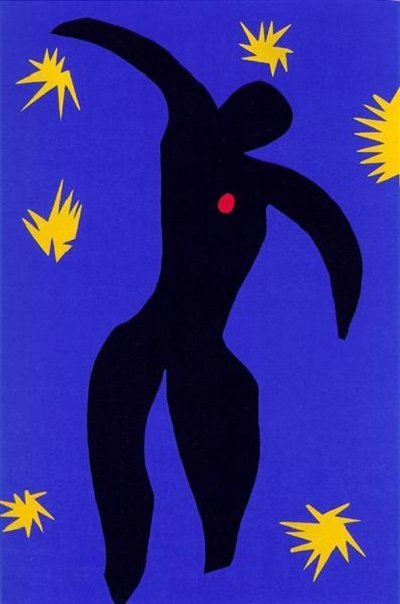Henri Matisse es uno de mis más queridos artistas plásticos, quien renovó la pintura del siglo XX de modo capital, en la tradición moderna de Van Gogh, Gaugin, Cézanne, Picasso, por nombrar cuatro de los más grandes. Estamos en los 70 años de su muerte (3 de noviembre de 1954).
Henri Matisse is one of my most beloved plastic artists, who renewed the painting of the 20th century in a capital way, in the modern tradition of Van Gogh, Gaugin, Cézanne, Picasso, to name four of the greatest. This is the 70th anniversary of his death (November 3, 1954).

Matisse, a raíz de una imposibilidad física producida por una enfermedad grave desde 1941, inició un estilo que llamó "pintura (o dibujo) con tijeras", que era una técnica de recortes de papel coloreado, que luego disponía en una composición, siguiendo un proyecto previamente elaborado. Así, hizo su libro ilustrado que denominó Jazz, comenzado en 1943 –en plena Guerra Mundial– y publicado en 1947, del cual forma parte "Icarus". Todas estas condiciones, más allá de lo mitológico, proporcionan diferentes y confluyentes posibilidades interpretativas a esta obra. De ahí el ejercicio que aquí les presento.
Matisse, following a physical disability caused by a serious illness since 1941, began a style that he called "painting (or drawing) with scissors", which was a technique of cutting out colored paper, which he then arranged in a composition, following a previously prepared project. Thus, he made his illustrated book that he called Jazz, begun in 1943 –in the middle of the World War– and published in 1947, of which "Icarus" is a part. All these conditions, beyond the mythological, provide different and converging interpretative possibilities for this work. Hence the exercise that I present to you here.

En el azul profundo del abismo, el alado de cera cae, como un héroe en declive, o un sacrificado del delirio humano. En el vacío su cuerpo baila la danza de la muerte o del éxtasis, en su negro cuerpo, con el punto rojo en su corazón, como un disparo certero. El sol fulgura en su derredor con sus destellos, cual explosiones celestes.
Ícaro, nombre de la ambición del ascenso y de la aventura fallida. Ícaro: el artista del trapecio retando el destino, el danzarín nietzscheano en la cuerda floja de la vida.

We are Icarus (exercise in poetic prose for Henri Matisse)
In the deep blue of the abyss, the waxen winged one falls, like a hero in decline, or a sacrificed of the human delirium. In the void his body performs the dance of death or ecstasy, in his black body, with the red dot in his heart, like an accurate shot. The sun shines around him with its flashes, like celestial explosions.
Icarus, name of the ambition of ascent and failed adventure. Icarus: the trapeze artist challenging destiny, the Nietzschean dancer on the tightrope of life.
Imágenes:
(1) https://hjck.com/cine-y-arte/henri-matisse-el-maestro-del-color
(2) https://www.wikiart.org/es/henri-matisse/icarus-1944
Referencias | References:
https://es.wikipedia.org/wiki/Henri_Matisse
https://en.wikipedia.org/wiki/Henri_Matisse
https://www.metmuseum.org/art/collection/search/337069
https://www.wikiart.org/es/henri-matisse





Posted Using InLeo Alpha
